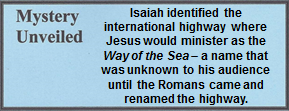06.01.01 Introduction
Since His miracle in Cana, the whole province of Galilee was talking about Him. Unlike today where cultural and technological changes are expected, in the ancient world, change happened so slowly it was hardly noticeable. The only exception was related to warfare, and that was never good. Therefore, when a certain Man from Nazareth began performing miracles, He was the subject of every conversation – on the boats, in the synagogues, in the marketplace, wherever people met. The news spread throughout all of the Jewish provinces, to Sidon far to the north, Idumea far to the south, throughout the cities of the Decapolis, and beyond. But the bulk of His ministry was in Galilee for these four reasons:
- Galilee had a higher concentration of Jews then did Judea and Jerusalem. Since Jesus came to present Himself to the Jewish nation, He obviously came to where most Jewish people lived, and in doing so He fulfilled Isaiah 9:1.
- The Galilean Jews were not as theologically rigid or prideful as their Jerusalem counterpart. Consequently, they were more open to receive His message of the Kingdom of God.
- The Sanhedrin had no arresting authority in Galilee.
- The Via Maris went through Capernaum. It was an international highway used by travelers going between Africa and Asia or Europe. When they stopped by the Sea of Galilee area, they heard of Jesus who performed many miracles and was wonderful teacher. When they continued on their way, the took the good news with them.
It appears that the significance of the Via Maris has all too often been overlooked. This important road was the great international coastal highway that connected Egypt with Galilee, Phoenicia, Syria and eventually went on to Mesopotamia. From there the Spice Route went to China. Its importance is underscored by the thirty-seven local connecting roads within Israel.[1] An amazing feature of Isaiah 1:9 that is often missed is that the prophet called the road by a name – the Way of the Sea. But that name did not exist in the days of Isaiah (about 700 B.C.), rather, it was known as the Way of the Philistines, or technically, the way of the land of the Philistines (Ex. 13:17; Num. 20:17).[2] However, in 63 B.C., the Roman General Pompey took control of Israel and renamed the highway the Via Maris, which is Latin meaning, the Way of the Sea, precisely what Isaiah called it.[3]

[1]. Dorsey, Roads and Highways. 57; Cosby, Interpreting Biblical Literature. 45.
[2]. It was also known as The Great Trunk Route (as in “tree trunk”) because it connected to so many secondary roads.
[3]. Smith, Augsburg Commentary on the New Testament: Matthew. 68-69.